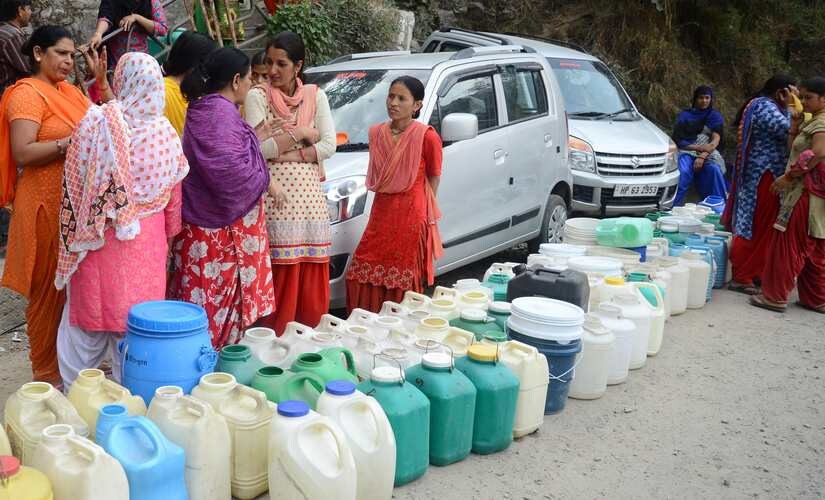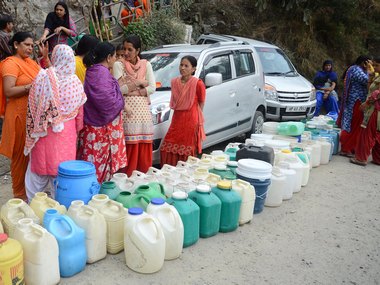Over the years, Shimla’s population has grown steadily and taken a toll on its resources. It is high time to look at possible solutions to the problem of the shortage of drinking water, especially in the light of global concern about climate change issues in the Himalayan region. Undoubtedly, successive state governments and the Shimla Municipal Corporation (SMC) have ignored the worsening situation. In June this year , there was no drinking water supply in Shimla for eight to ten days —a situation that had forced hoteliers to put up boards advising tourists not to visit the town. Sunita Narain, noted environmentalist and director, Centre for Science and Environment, who was in Shimla to address a conference on climate change issues some time back, drew a parallel with Cape town, a reference which annoyed the city’s Deputy Mayor Rakesh Kumar, who was present in the function. Six months down the line, the ‘queen of hills’ will face a reality check of sorts this winter, during the snow season which attracts thousands of tourists. What lessons have the town and the state government learnt from the worst-ever water crisis? Has the problem been fixed? These are questions awaiting answers. [caption id=“attachment_5643441” align=“alignnone” width=“825”]  People with empty water containers waiting for a water tanker in Shimla. Photo by Pradeep Kumar[/caption] As of now, there is a dramatic improvement in the availability of drinking water in Shimla. A series of steps taken by Shimla Jal Prabandhan Nigam — an entity formed to manage the city’s water and sewerage affairs — has led to a cumulative discharge of 49 MLD of drinking water from all eight sources. This is more than double the availability of drinking water during the water crisis period, when it had dropped to 19 to 20 MLD. Shimla’s average requirement is 40 to 44 MLD. The turnaround has mainly been the result of the internal management and plugging of huge leakage of water from old pipes and a faulty distribution system. With availability having increased, the municipal corporation plans to introduce a trial run of 24X7 water supply in some of the municipal wards. Officials expect good snowfall this winter, and say that there will never be a repeat of the situation from this year’s summer. Rajesh Kashyap, executive engineer (water supplies) explains some of these aspects. In January 2016, a jaundice outbreak had forced the municipal corporation to shut down water supply from Ashwani Khad (which has a capacity of 10 MLD). As an alternative scheme, the Koti Brandi project has been commissioned to add 5 MLD of water. The Giri water supply scheme, which has a capacity of 20 MLD but used to supply only 12 MLD, was renovated with an investment of Rs 4.50 crore. An additional 8 MLD has been added now, due to which it runs on optimum capacity. At Gumma — Shimla’s oldest and main water supply scheme which was commissioned during the British era — four pumps have been replaced at a cost of Rs 3.50 crore. The scheme now supplies 21 MLD of water. On 29 September, the municipal corporation created a record of sorts by pumping 52.05 MLD of water against an installed capacity of 54 MLD. Is this change sustainable for Shimla? It is important to consider that the impact of changes in weather patterns (erratic rains and less snowfall) have already hit availability of water discharge at natural sources. One cannot ignore the effect of massive construction activities in and around Shimla, forest felling, indiscriminate dumping of debris along hillsides and growing pollution on water availability. Dr Manmohan Singh, Director, Meteorological Centre, Shimla says that climatic changes have a direct bearing on the availability of water at perennial sources . “There has been a rise in extreme weather conditions due to global warming and pollution. Prolonged dry spells result in a scarcity of water, and excessive rains lead to flash floods and landslides. Mountains are more vulnerable to such things,” he says. Shimla’s water crisis is not a new phenomenon. During the British era, the city was the summer capital of the colonial government, and had a population of about 30,000. Now, it has exceeded the two lakh mark. During tourist reason, 15,000 to 20,000 tourists reach Shimla. Thus, hoteliers have to make arrangements for meeting additional water needs. As per a study done by WAPCOS Ltd, around 47 percent of drinking water pumped for supply to the town goes waste due to leakages in old pipelines, and a faulty distribution system, apart from mismanagement . “Now, after the replacement of the old pipeline from Creigneno to Dhalli, the leakages have been effectively plugged with an investment of Rs 8 crore. Improvements have also been made in the distribution network. This has resulted in the availability of additional drinking water for consumers," Pankaj Rai, Commissioner of the Shimla Municipal Corporation said. The completion of a Rs 292 crore World Bank-funded Kol Dam lift water supply scheme is now being awaited. The project — conceived three decades ago — would bring an additional 75 MLD of water from Satluj river. Shimla’s former Mayor Tikender Panwar says, “The water crisis during the summer this year was a wake-up call for many towns in India.The need is to think of climate-resilient strategies as a long term measure, apart from looking at Shimla’s overall sustainability, growth, construction and revival of old water bodies, recharging ground water and introducing rain water harvesting”.
It is high time to look at possible solutions to the problem of the shortage of drinking water in Shimla, especially in the light of global concern about climate change.
Advertisement
End of Article


)

)
)
)
)
)
)
)
)



